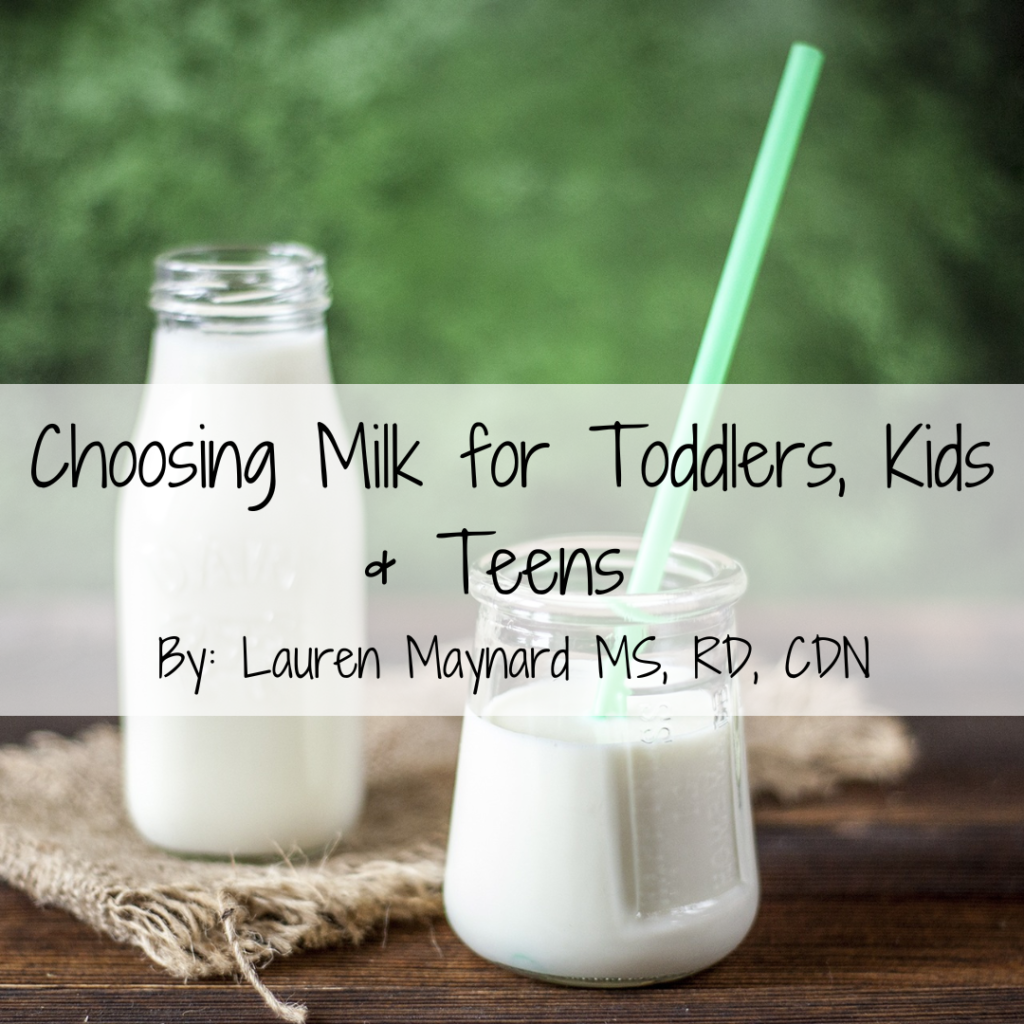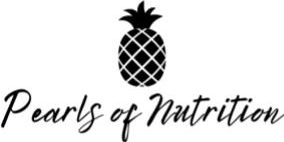
If you’ve been to the grocery store lately you may have noticed that the milk aisle continues expanding. From deciding the source of milk to choosing a flavoring, the options seem endless. You may be wondering if some have a better health benefit than others. You may also find your family has different preferences. As a dietitian who works with all ages, I find it important to honor those preferences while also making sure we are choosing the most supportive products, especially for our growing kiddos!
Here are a few areas we will touch on in this article:
- Recommended frequency of milk consumption
- Milks role in growth and development
- Cow’s milk allergy vs lactose intolerance
- Alternative milk options
Introducing Milk Let’s start from the beginning… The American Academy of Pediatrics (AAP) recommends exclusive breastfeeding throughout the first 6 months of life and the World Health Organization (WHO) recommends continuing until 2 years of age in conjunction with complementary foods. Breastfeeding is strongly recommended because it is the perfect match for your baby’s needs. In fact, breast milk composition changes as your baby grows to meet their needs! The types of carbohydrates in breastmilk are extremely diverse which provides the necessary food for the infant’s intestinal bacteria. This is important because the gut microbiome plays a crucial role in the development of the immune system. In addition to the nutritional benefits, breastfeeding has been shown to lower risk of ear and respiratory infections, asthma, allergies, inflammatory bowel disease, certain autoimmune conditions like celiac disease and type I diabetes, sudden infant death syndrome, certain leukemias and more!
At 6 months old, regardless of being formula-fed or breast-fed, it is recommended to begin introducing a combination of solid foods alongside breast milk/formula. However, cow’s milk should not be offered until 12 months of age. Offering cow’s milk before this point is not required to meet your baby’s needs and also puts them at health risks as their body simply isn’t ready for it yet.
Once that first birthday hits, choosing what milk to offer may feel confusing. The AAP recommends offering whole cow’s milk and as Registered Dietitians (RDs), we couldn’t agree more! Our kiddos need the fat whole milk provides in order to support their rapid growth and development, a topic we will continue to discuss.
Frequency of Milk consumption
Toddlers: The recommendation for toddlers (12-24 months) is to provide whole milk 2-3 times/day or about 16-24oz. This ensures that they are meeting their recommended daily calcium needs. Since milk can be filling, offering more than recommended begins to push out other important foods and nutrients, such as fiber or iron, which they are unable to get from milk.
Although this article focuses primarily on milk, offering a variety of dairy products like yogurt, cheese and kefir can be a great way to meet their calcium needs if they simply do not like milk. We recommend offering the full-fat version of these as well because again, fat is our kiddos friend!
Kids and Teens: The recommendation does not significantly increase for adolescents and teens. Their diet tends to be varied and of larger volume so aiming for 3 servings of dairy each day is an appropriate way to help meet their calcium needs plus other nutrients as well. Similar with our toddlers, we recommend continuing to offer whole milk products when possible as this fat is still playing an important role in supporting their ongoing growth and development but also their cognition in school/sports because fun fact, our brains are 60% fat! Additionally, milk contains vitamin D which is a fat soluble vitamin, meaning our absorption of it is best when we have a fat containing meal. Not to mention, milk which contains fat tastes better than skim milk! Again, if your child dislikes milk, offering other dairy products is just as supportive.
Once a child reaches adolescence and shortly after begins entering puberty, it is important to remember that they should be growing and gaining weight quite rapidly. On average, adolescents gain about 40 lbs during peak development, which lasts about 2 years after the onset of puberty. Of course this varies kid to kid but know that this growth is crucial! During that roughly two year period, they are accruing the bulk of their bone density to support their adult bodies. This rapid growth and shift in hormone production (ie. estrogen and testosterone) requires a ton of nutrition! If we underproduce these hormones, not only are they at risk for irreversible bone density loss but we will likely see a plateau in overall growth and development. How does this tie into milk? That’s one part of the equation for success!
Choosing a Milk Product [See the table below for full nutrient comparisons of popular milk options]
Cow’s Milk Allergy vs Lactose Intolerance – What’s the difference?
Being diagnosed with a cow’s milk allergy or lactose intolerance are two common reasons to look for a milk alternative. Knowing the difference can be helpful in determining what to choose.
A cow’s milk allergy is an immune mediated reaction to a protein in milk (casein or whey). There is about 2-3% prevalence in the U.S. and is often diagnosed by age one. Most symptoms occur within 1-2 hours of consuming cow’s milk products and can include difficulty breathing, coughing, wheezing, atopic dermatitis, throat tightness, abdominal pain, vomiting, diarrhea, dizziness and confusion. Testing is typically performed via a skin test in a doctor’s office.
Milk alternatives: A milk allergy requires an avoidance of all cow’s milk products. Soy milk tends to be the most suitable in terms of nutrient comparison. Pea milk is also a supportive option but may be more challenging to find in the store. Lactose free products would be inappropriate since these would still contain the cow’s milk proteins – keep reading for more on that.
Lactose intolerance is an inability to break down the natural sugar present in milk/milk products, lactose. Our small intestine (the main organ involved in nutrient absorption) makes an enzyme called lactase. Lactase breaks down lactose into its most usable parts which are the simple sugars galactose and glucose so that we can absorb and use them for energy – pretty cool stuff! Someone with a lactose intolerance simply doesn’t make enough lactase and the breakdown process doesn’t happen. The digestive system goes “hmm, I guess we just try to get rid of this weird thing” and the bacteria in your intestines will consume it instead. This often leads to symptoms like abdominal pain/cramping, bloating, gas and diarrhea. Lactose intolerance often runs in families and an avoidance of lactose containing products is required. The most common forms of testing include hydrogen breath testing or stool testing. Again, all should be done with a medical practitioner in office.
Temporary lactose intolerance can occur after an illness such as the stomach bug or from lack of chronic undereating (lack of nutrition overtime can lead to an inadequate production of this enzyme). Often a slow reintroduction of dairy products allows the body to begin producing lactase effectively again and digestive discomfort goes away.
Milk Alternatives: Since there is not a cow’s milk protein concern, we can still choose a cow’s milk product but simply opting for one without lactose. You can look for the words “Lactose Free” on the product’s packaging and you will also see “lactase enzyme” listed in the ingredients. Some common brands are Lactaid, Fairlife or Horizon and most stores will also have a generic version of these as well.
If your home avoids cow’s milk products for whatever reason, here are some things to consider when choosing milk alternatives:
Protein is a crucial macronutrient for growth and development for children of all ages. It supports the development of muscles, bones, organs/tissues and the immune system. Cow’s milk naturally has about 8g of protein per 8 oz serving which contributes really well to overall daily protein. If you need to find a milk alternative, this is a good goal to aim for.
Appropriate alternatives: The AAP recommends Soy milk as the next best alternative when it comes to protein as it offers 8g per 8 oz serving, which is comparable to cow’s milk. Pea milk also offers 8g per serving but again it may be harder to find in the store. Most other plant milks will be very low in total protein. It’s not to say they can never be offered but they unfortunately fall short in this category so we highly recommend working with a dietitian to better assess how to meet protein needs throughout the day if cow’s milk or soy are not options for your family.
Fat is another crucial macronutrient for brain development and cognition throughout a child’s entire life. Not only is fat essential for development but it also keeps our kiddos full and satisfied much longer which is a great way to reduce the “Mommy, I’m hungry” comments. Fats also aid in the absorption of fat soluble vitamins such as Vitamins A and D that are also present in milk which makes milk a great package deal. Whole cow’s milk has 8g of total fat per 8 oz serving.
Appropriate alternatives: Finding an alternative milk product with adequate fat content is pretty tricky. Most alternatives offer less than half of the amount we would get through whole cow’s milk. We recommend offering other sources of fat throughout the day at meals and snacks: peanut butter (or any seed/nut butters), avocado, whole eggs, olive oil or butter.
What about DHA?Some milk products will have added DHA. DHA or docosahexaenoic acid (say that 5 times fast) is a type of Omega-3 fat that plays an important role in brain and nervous system development. It is often incorporated into prenatal vitamins as it plays a crucial role in early brain development during pregnancy. If the milk you purchase does not have added DHA, which is the vast majority, other sources include tuna, salmon, flaxseed, walnuts and eggs that are great to offer!
Calcium plays a crucial role in bone development. About 99% of our body’s calcium is stored in our bones/teeth! Cow’s milk provides 300 mg of calcium per 8 oz serving which meets >50% of the calcium requirement for toddlers and 25-40% for adolescents/teens.
Appropriate alternatives: Most milk alternatives do a good job of adding in an amount of calcium that is equivalent to cow’s milk. There are some brands that do not, so just make sure to double check the ingredients and food label. *Calcium citrate is a well-absorbed version of calcium so you can also look for that in the ingredients list as well!
Vitamin D is a fat soluble vitamin that has been added to milk since the early 1900s as a public health initiative to reduce the risk of poor bone development (rickets) in children. Vitamin D helps to increase the amount of calcium we absorb so these two pair wonderfully in milk!
Cow’s milk has about 2 mcg of added Vitamin D.
Appropriate alternatives: Similar to calcium, most milk alternatives (with the exception of banana milk) have added vitamin D in equivalent amounts. *Vitamin D supplementation outside of dairy is a common concern (especially in Rochester, NY) and I recommend speaking with your pediatrician and/or pediatric dietitian for more information on any additional Vitamin D, based on your child’s age.
Vitamin A is another fat soluble vitamin found in milk. It plays an important role in supporting healthy eyesight, the immune system and general growth and development. We tend to absorb this vitamin the most efficiently from animal products like milk!
Appropriate alternatives: Most plant alternatives, with the exception of a few, have adequate amounts of added Vitamin A. Be sure to check the vitamins section of the food label to be sure.
Milk Options & Nutrients of Importance
(8 oz serving) | Protein | Fat | Calcium | Vitamin D | Vitamin A |
| Whole Cow’s Milk | 8g | 8g | 300mg | 2mcg | 80mcg |
| Whole Lactose Free | 8-13g* | 8g | 300mg | 2.5mcg | 90mcg |
| Soy | 8g | 4.5g | 450mg | 3mcg | 150mcg |
| Almond | 1g | 3g | 450mg | 2mcg | 140mcg |
| Coconut | 0g | 4g | 470mg | 2mcg | 180mcg |
| Cashew | 1g | 2g | 470mg | 2mcg | 140mcg |
| Oat | 3g | 5g | 350mg | 3.6mcg | 160mg |
| Pea | 8g | 4g | 440mg | 5mcg | 90mcg |
| Rice | 0g | 2.5g | 280mg | 2mcg | 150mcg |
| Flax | 0g | 2.5g | 270mg | 2mcg | 130mcg |
| Banana | 1g | 3g | 290mg | 0mcg | 0mcg |
Takeaways: As we can see, there are a variety of reasons we see so many milk products available on the market. I’m hopeful a better understanding of nutrients of importance and how they play a role in our children’s development allows you to feel more empowered when making decisions!
Here are a few main points to remember:
- As long as your child does not have a milk protein allergy, choosing whole cow’s milk is appropriate and extremely beneficial to offer adequate protein, fat, calcium and both Vitamin’s D and A.
- If your child simply doesn’t like the taste of milk, you can try adding milk to smoothies/milkshakes, oatmeal, sauces, scrambled eggs or baked goods. You can also offer other dairy products like yogurt, cheese and kefir as a part of a meal/snack or in some of the above ideas as well.
- Using a fun cup and/or straw can also be a great way to make milk more enjoyable!
- Although most plant products offer adequate amounts of vitamins through fortification, protein and fat are often lacking which are crucial for growth and development. Consider your child’s age, their growth and food group variety.
- If you find that your teen wants to switch to non-dairy products, we recommend exploring their desire for this and continuing to offer the products you feel to be most appropriate!
As mentioned throughout, we recommend working collaboratively with your child’s healthcare team and we would love to be a part of that collaborative journey!
Resources:
Danahy, A. (2020, February 21). Vitamin D milk: Everything you need to know. Healthline. https://www.healthline.com/nutrition/vitamin-d-milk#benefits
Desiraju, M. (Ed.). (2022, June). Weaning your child (for parents) – nemours kidshealth. KidsHealth. https://kidshealth.org/en/parents/weaning.html
Desiraju, M. (Ed.). (2022b, June). When can babies start drinking cow’s milk? (for parents) – nemours kidshealth. KidsHealth. https://kidshealth.org/en/parents/cow-milk.html
Flom, J. D., & Sicherer, S. H. (n.d.). Epidemiology of Cow’s Milk Alllergy . https://www.ncbi.nlm.nih.gov/pmc/articles/PMC6566637/ Lactose intolerance.
Johns Hopkins Medicine. (n.d.). https://www.hopkinsmedicine.org/health/conditions-and-diseases/lactose-intolerance#:~:text=Lactose%20intolerance%20happens%20when%20your,drinking%20milk%20or%20milk%20products
Bode L. Human milk oligosaccharides: every baby needs a sugar mama. Glycobiology. 2012;22:1147–1162.


